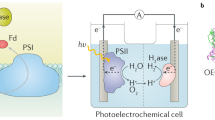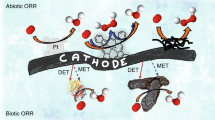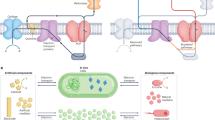Abstract
Recent reports have demonstrated the possibility of using photoactive, biological membrane components in photoelectro-chemical cells1. Such systems have produced small photovoltages and photocurrents. The present studies in our laboratories have led to the attachment of a much simpler biological complex, the bacterial photosynthetic reaction centre isolated from Rhodopseudomonas sphaeroides, directly onto an SnO2 electrode. The light-induced, primary-charge-separation processes which occur across the reaction-centre macromolecule have been coupled to the electrode, and in a two-electrode configuration photovoltages of 70 mV and photocurrents of 0.3 µcm−2 have been observed in an external circuit. The phenomena are not due to Dember effects, and ‘reactor-centre electrodes’ may serve as a model system for future photovoltaic devices.
This is a preview of subscription content, access via your institution
Access options
Subscribe to this journal
Receive 51 print issues and online access
$199.00 per year
only $3.90 per issue
Buy this article
- Purchase on Springer Link
- Instant access to full article PDF
Prices may be subject to local taxes which are calculated during checkout
Similar content being viewed by others
References
Bolton, J. R. & Hall, D. O. Ann. Rev. Energy 4, 349–397 (1979).
Allen, M. J. in Living Systems as Energy Converters (eds Buvet, R. et al.) 271–274 (Elsevier, Amsterdam, 1977).
Ochiai, H. et al. Agric. biol. Chem. 43, 181–183 (1979).
Haehnel, W. et al. Z. Naturforsch. C 23, 392–401 (1978).
Gross, E. L. et al. Photochem. Photobiol. 28, 249–256 (1978).
Skulachev, V. P. FEBS Lett. 64, 23 (1976).
Packer, L. et al. in Living Systems as Energy Converters (eds Buvet, R. et al.) 119–128 (Elsevier, Amsterdam, 1977).
Drachev, L. A. et al. FEBS Lett. 50, 219 (1975).
Seibert, M. in Current Topics in Bioenergetics (eds Sanadi, D. R. & Vernon, L. P.) 39–73 (Academic, New York, 1978).
Seibert, M. & Janzen, A. F. Proc. 2nd Miami int. Conf. Alternative Energy Sources (in the press).
Clayton, R. Brookhaven Symp. on Biology 28, 1–15 (1977).
Seibert, M. et al. AIChE Symp. Ser., No. 181, 74, 42–46 (1978).
Dutton, P. L. et al. FEBS Lett. 60, 275–280 (1975).
Gerischer, H. & Willig, F. in Topics in Current Chemistry (eds Davison, A. et al.) 31–84 (Springer, Berlin, 1976).
Mountz, J. M. & Tien, H. Ti, Photochem. Photobiol. 28, 395–400 (1978).
Miyasaka, R. et al. J. Am. chem. Soc. 100, 6657–6665 (1978); Nature 277, 638–640 (1979).
Janzen, A. F. & Bolton, J. R. J. Am. chem. Soc. 101, 6337–6341 (1979).
Wasielewski, M. Abst. 3rd Solar Photochemistry Research Conf. 76–80 (1979).
Author information
Authors and Affiliations
Rights and permissions
About this article
Cite this article
Janzen, A., Seibert, M. Photoelectrochemical conversion using reaction-centre electrodes. Nature 286, 584–585 (1980). https://doi.org/10.1038/286584a0
Received:
Accepted:
Issue Date:
DOI: https://doi.org/10.1038/286584a0
This article is cited by
-
Pathways to a net-zero-carbon water sector through energy-extracting wastewater technologies
npj Clean Water (2022)
-
Bioelectronics and biometallocatalysis for production of fuels and chemicals by photosynthetic water splitting
Applied Biochemistry and Biotechnology (1995)
Comments
By submitting a comment you agree to abide by our Terms and Community Guidelines. If you find something abusive or that does not comply with our terms or guidelines please flag it as inappropriate.



